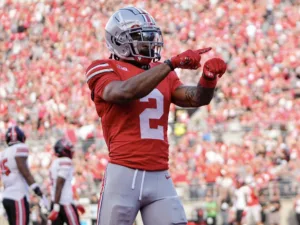
Can College Yards After Catch Help Predict NFL Success For Wide Receivers?
For our 61 part “Does It Matter?” series, we looked into whether a Wide Receiver’s College Yards After Catch per Reception (YAC/Rec)
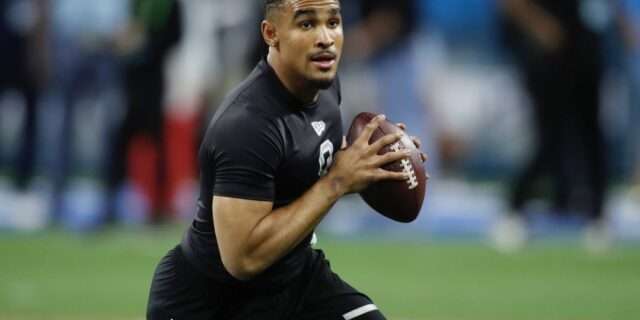
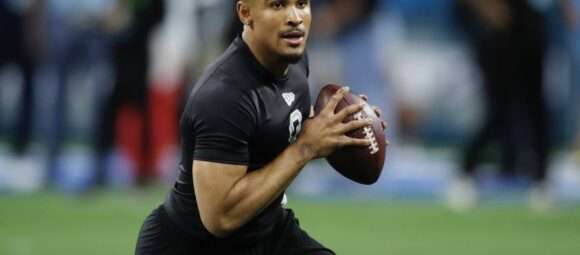
One topic in Fantasy Football which we wanted to dive into is whether there is a trend in the top QB’s sizes. So, does size matter? To shed light on this topic, we conducted a market research study focusing on the top 30 fantasy football scoring quarterbacks from 2003 to 2023. Then we further honed that in to the top 5 every year. We are going to study heights and performance based stats next. For now, this article dives into our findings focusing only on weight, highlighting the relationship between the top NFL quarterbacks and their weight.
Our research methodology was as follows: We excluded rookie NFL quarterbacks to eliminate the variable of initial adjustment to the league. The analysis was based strictly on NFL draft combine weights, ensuring a standardized benchmark for comparison. We segmented our data into various groups of seasonal fantasy points finishes: the average top 1, top 3, top 5, top 10, the 11th to 20th, and the 21st to 30th finishers. We calculated the average weight within each group to identify any discernible patterns. That chart is seen below:
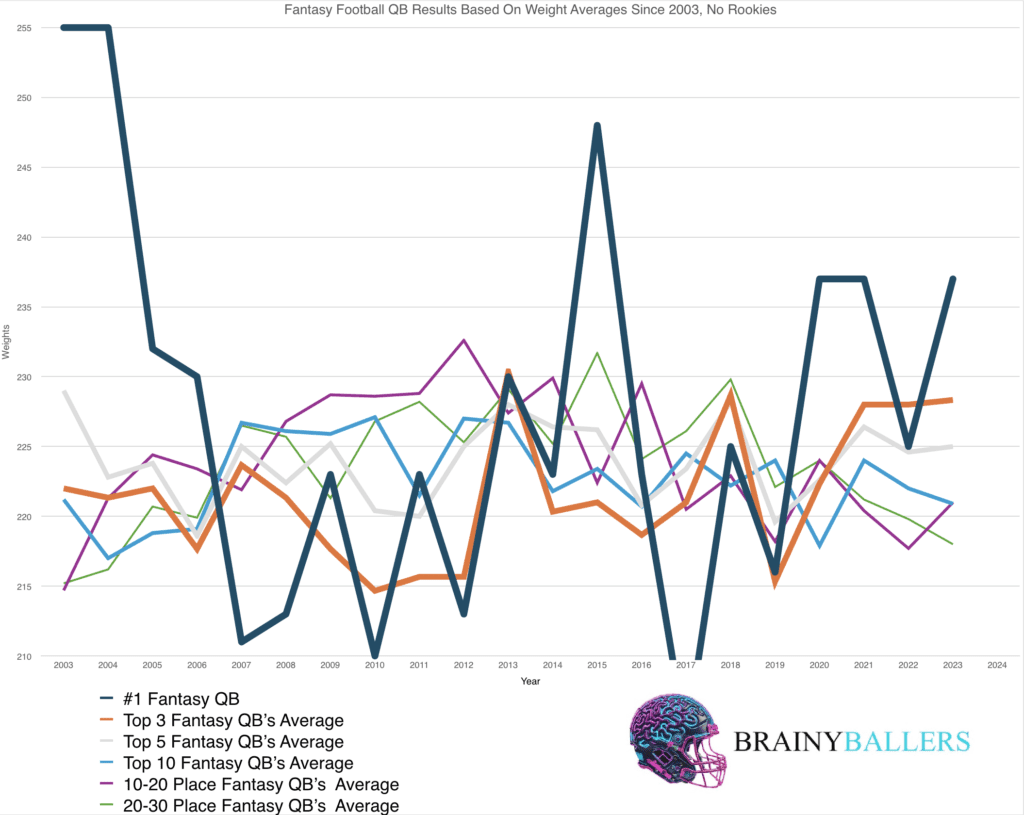
Our initial analysis aimed to uncover trends across the broader spectrum of NFL quarterbacks. This proved to be challenging, with the data presenting no clear correlation between a quarterback’s weight and their fantasy football finish. However, a notable pattern emerged when focusing on the top 5 performers (light-grey trend line). The average weight of the top 5 quarterbacks consistently ranged between 220 and 226 pounds. This suggested a potential sweet spot for quarterback size in terms of weight. However, these are only averages. That makes it hard to visualize the actual weights of the top QB’s. This raises concerns of whether the 220-226 range actually is a sweet spot or just a lucky average. Therefore, we dove further into non-averages and wanted to visualize each and every elite Quarterback’s weight.
To be able to visualize this without averages, we concentrated on the true elites of the league – the top 5 finishers. As seen below, 70 out of 105 top 5 finishes weighed between 211 and 230 pounds. Accounting for 67% of total finishes. Further, 221-226lbs – which we found to be the highest quantity 6 pound range of top 5 performers – accounts for 28.5% of these elite performers.
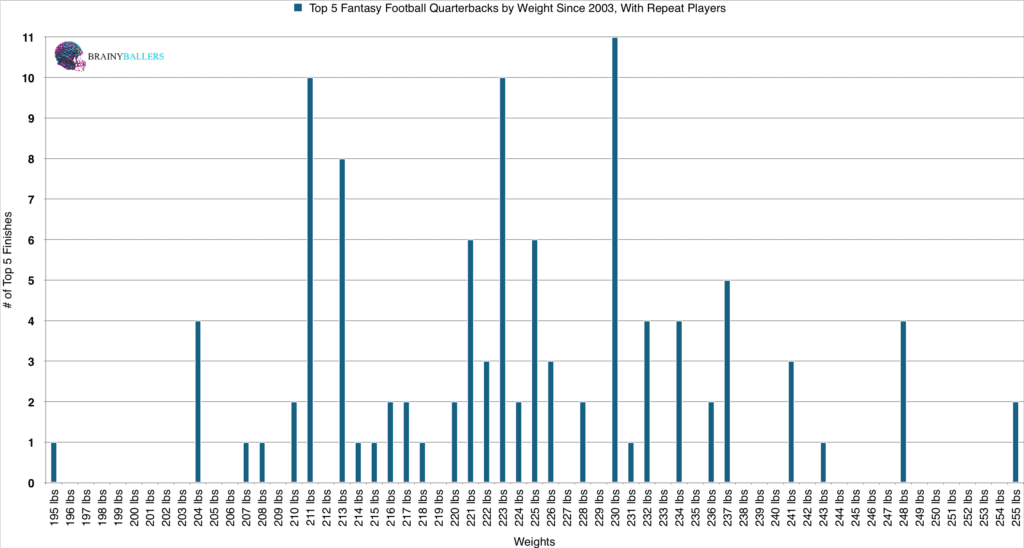
It’s worth mentioning that Tom Brady accounts for a majority of the 211 weight line, his NFL Combine weight. Although, it is widely known that he later upped his weight to 225 pounds during his career. No data could be found on exactly when this occurred. Therefore, we had to stick to his and everyone else’s NFL combine weight.
This detailed evaluation could reveal that the most consistently successful NFL quarterbacks typically fall within the weight range of 211 to 230 pounds. Although, the question then becomes is this trend repeatable throughout the fantasy football leaderboards? In other words, did we just find a trend for all QB’s? Or is this only the top 5 finishers that are mostly within this weight range? We have those results as well!
To solve this, we next focused on players who finished between 6-30 in the fantasy football leaderboards. As stated for the Top 5 finishers, 67% finished between 211-230lbs and 28.5% finished between 221-226. This may sound like a substantial amount. Although, when calculating the amount of quarterbacks who finished between 6-30 in these same seasons since 2003, the breakdown is as follows:
211-230lbs: 67% (no change)
221-226lbs: 24.5% (4% decrease from the Top 5 finishers)
From this, only a very slight – and almost unnoticeable – trend may be detected in the 221-226lb range. Showing a possible higher success rate when within this range. With this possible trend, the question then becomes is the a steady decline to the bottom of the leaderboards?
Across 105 Quarterbacks since 2003, 59 of them were between 211-230 pounds. This accounts for 56% of all quarterbacks in the bottom 5 since 2003. 11% lower from the Top 5’s percentage of finishes within that weight. Possibly a slight indicator that more reliable fantasy production comes from this weight class.
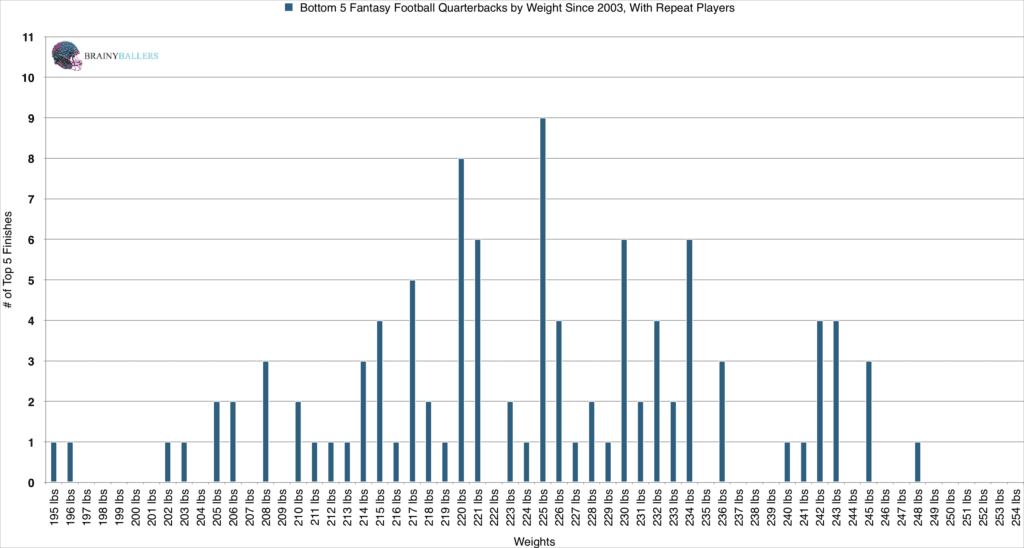
A concern arose from this data of whether only a handful of QB’s account for the 211 to 230 concentration. In other words, is there an higher quantity of athletes outside the 211-230, just not as many repeat Top 5 finishes? By taking out the repeat players in the Top 5, we were able to visualize that as well.
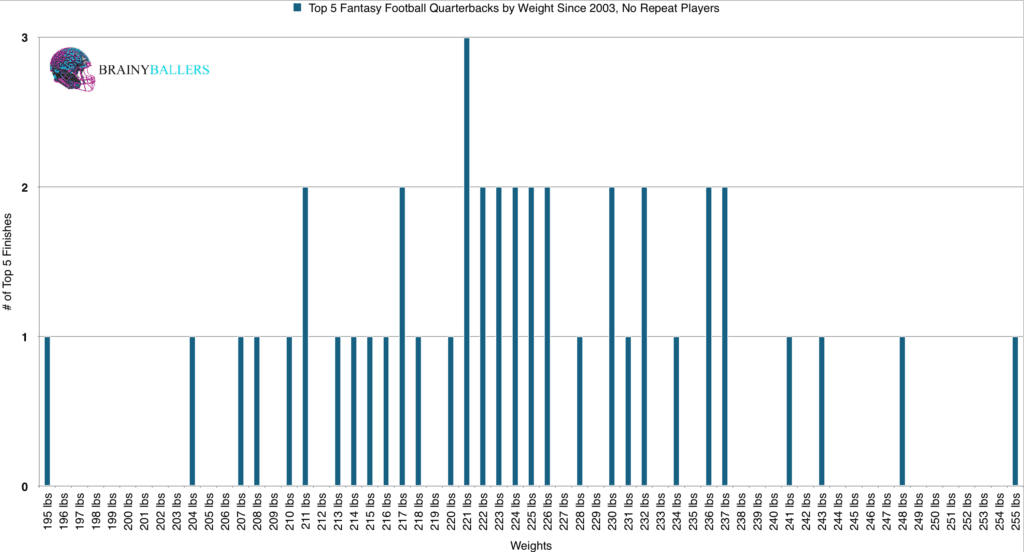
From this, we were able to see that there is an even further concentration of data between 221-226 pounds. Out of 43 NFL Quarterback’s in this data, 13 of them are between 221-226 pounds. Accounting for 30.2% of this data. This data may provide justice to the hypothesis that size, in terms of weight, does play a role with elite quarterbacks. But again, what about the bottom finishers? Here’s that chart:
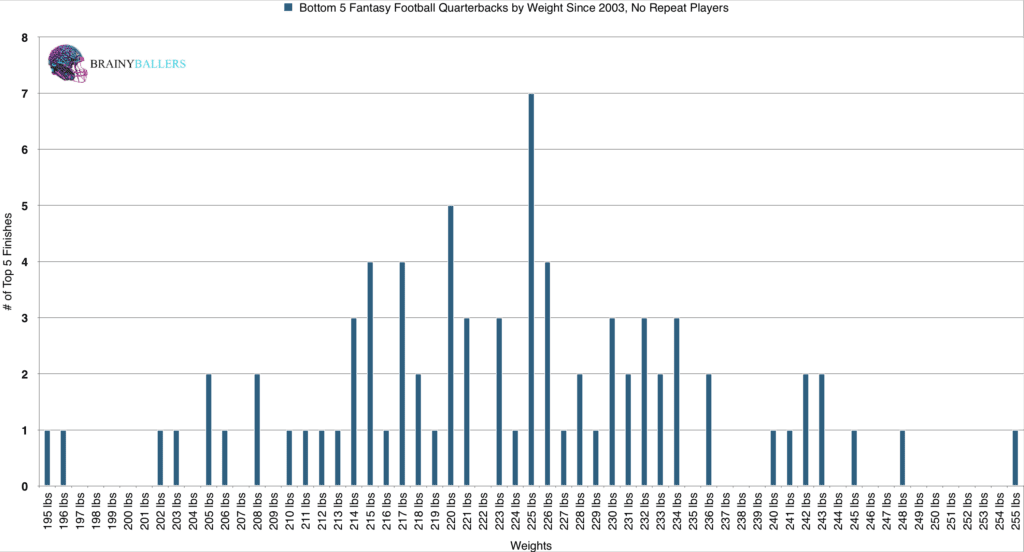
Looking at the bottom 5 finishers, 18 of 73 athletes appear between 221-226. This is 24.6%, compared to the Top half boasting 30.2% within the 221-226 pound range. Another boost in value, but the question arises whether it’s enough of one to consider this a done debate?
The NFL has changed drastically since 2003. Therefore, all the data we derived from this may be just meshing two realities together. But not to worry: our numbers crunching addiction took hold once again. Here’s the breakdown between 2004-2013 and 2014-2023 focusing on the top 5, 6-25, and bottom 5 finishers for both of those decades:
2004-2013:
(211-230lbs) Top 5: 74%, 6-25: 53.6%, Bottom 5: 54% (221-226lbs) Top 5: 22%, 6-25: 21.2%, Bottom 5: 28%
2014-2023:
(211-230lbs) Top 5: 58.8%, 6-25: 57.6%, Bottom 5: 58% (221-226lbs) Top 5: 30.9%, 6-25: 20.4%, Bottom 5: 28%
From this decade split, there’s 2 trends seen:
Using standard statistical methods, we explored the correlation between weights and NFL performances. Here are our findings:
These results showed an insignificant correlation between a QB’s weight and their NFL fantasy production. Given our focus on world-class athletes, a Pearson value over 0.1 or under -0.1 is significant for indicating predictive power. For reference to something that everyone acknowledges matters in prospect scouting, and to show the accompanying Pearson value, RB draft capital prevailed a -0.234 Pearson value.
Weight could play a small factor in our Star-Predictor Score (SPS) model. The Star-Predictor Score (SPS) is a scouting tool designed to maximize investment potential and reduce risks when drafting rookies in Fantasy Football. It is proven to have a higher accuracy than draft capital alone to predict fantasy success. The SPS includes 13 to 17 metrics, with the exact number varying by the player’s position. All these metrics are pre-NFL, and some are invented by us, providing a complete analysis of a player’s analytical profiles. The SPS gained widespread notoriety for its high accuracy, having made it on Barstool and The Pat McAfee Show. The SPS can be found here.

What 3 metrics matter the most when scouting a rookie Quarterback? What threshold should Quarterbacks achieve within those metrics to be considered an elite prospect? How much should you value those stats above all other stats? Couldn't answer those questions? Rest easy, we have it handled for you. That's what this chart answers. Sort by importance and/or filter by position. Unlock by signing up with the links provided. $9.99/Year or $24.99 Lifetime access. Cancel anytime.
As seen in all this data, there is a recent clear and focused improvement going from the bottom 5 finishers to the top 5 finishers in the 221-226lb range. Further, there should be more than enough data points to validate this research. Although, with only a 9% improvement of athletes showing up in the 221-226 pound range from the bottom 5 to the top 5, we don’t see enough of an improvement to say weight plays a significant factor in NFL Quarterback performance. Although, it is pretty clear that if you weigh outside the range of 211-230 pounds, you may struggle making even the top 30 fantasy football finishes. With 67% of all top 30 fantasy finishes since 2003 being between 211-230lbs that becomes clear.
Additionally, it’s reasonable to believe that Brady’s motivation to become a great NFL quarterback drove his weight gain. This level of dedication is nearly impossible to pinpoint on prospects, even when taking into account what they say as everyone can simply talk a big game. However, if an athlete is already within this weight range, they have one fewer obstacle to overcome. Of course that is assuming weight is a factor, which it appears to atleast slightly play a part in it.
Further, with these all being numbers from the NFL Draft Combine, you can check your favorite/sleeper quarterbacks’ Combine results before your Dynasty drafts involving rookies to be sure “your guy” is not outside that range. No need to check this year, though, we got you covered there:
Amongst the 2024 rookie class, our findings offer intriguing insights. Quarterbacks such as Jaydon Daniels, Jordan Travis, and Austin Reed fall outside the 211-230lb weight range. Conversely, Drake Maye’s weight of 223lbs places him squarely within the recent weight trend bracket of 221-226.
Our series has always sought to push the boundaries of sports analytics, and this latest installment reaffirms our commitment to uncovering the hidden dynamics that define the game. Every Saturday We will dive deep into the most intriguing questions, bust myths, and settle debates with thorough analysis similar to this. We thrive on curiosity and welcome your input — so please, leave comments or reach out to us with topics you’re eager to see dissected next. All of our research can be found on our Analytics Page. Up next on our agenda for Part 2 of “Does It Matter?” is our next examination of NFL Quarterbacks: Does Height Matter? If so, what’s the Height threshold necessary for success? Mark your calendars; every Saturday we shed light on the topics that matter to you. All it takes is a quick question being asked and we will go to work for you!


Related Content:

For our 61 part “Does It Matter?” series, we looked into whether a Wide Receiver’s College Yards After Catch per Reception (YAC/Rec)

In part 60 of our “Does It Matter?” series, we dove into the question of whether a college Wide Receiver’s career Average

The “Does It Matter?” series, part 59 looked to uncover the role of a quarterback’s rookie touchdown per game (TD/G) in predicting
© 2023 BrainyBallers | All Rights Reserved